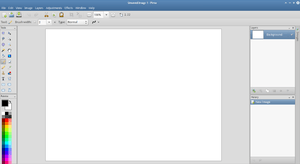Pinta (software)
|
| |
|
Simple Painting for Gtk. | |
| Original author(s) | Jonathan Pobst |
|---|---|
| Developer(s) |
|
| Initial release | February 7, 2010 |
| Stable release |
1.6
/ March 1, 2015 |
| Development status | Active |
| Written in | C# (GTK#) |
| Operating system | Linux, Mac OS X, Windows |
| Platform | Mono/GNOME |
| Size |
|
| Available in | Multilingual (55 languages) |
| Type | Raster graphics editor |
| License | MIT X11 |
| Website |
pinta-project |
Pinta is an open-source, cross-platform bitmap image drawing and editing program inspired by Paint.NET, a similar image editing program which is limited to Microsoft Windows.[2] Pinta has more features than Microsoft Paint. Compared with open-source image editor GIMP,[3] Pinta is simpler and has fewer features.
Features
Pinta is a bitmap image editor with many features typical of image editing software including drawing tools, image filters and colour adjustment tools.[3] The focus on usability is reflected in several of the main features of the program:
- Unlimited undo history.[4]
- Multiple language support.
- Flexible toolbar arrangement, including floating as windows or docking around the image edge.
Unlike some simple image editing software, Pinta also features support for image layers.[4]
History and development
Development of Pinta began in February 2010 and was driven by Jonathan Pobst, then working at Novell.[5][6] In September 2011 Pobst announced that he was no longer interested in developing Pinta.[7] A new group of developers continued the project.[3][8]
Pinta is written in C# and uses the GTK+ toolkit and the cairo library. The code adjustment and effect filters, originally came from Paint.NET but otherwise the project is original code.[6] Pinta is under active development.
| Version | Release date | Major changes |
|---|---|---|
| 0.1 | February 7, 2010 | Initial release |
| 0.2 | March 15, 2010 | Improved layer and history windows; zoom, paint bucket, color replacer, line, and pan tools; live preview for layer changes; multithreading support for effects and adjustments |
| 0.3 | May 3, 2010 | Live preview for adjustments and effects; pixel-precise zoom; gradient, magic wand and text tools; 26 new effects ported from Paint.NET |
| 0.4 | July 6, 2010 | Internationalization support; docking windows; OpenRaster support; saving in BMP, ICO and TIFF formats in addition to JPEG and PNG |
| 0.5 | November 2, 2010 | Multiple image support; TGA format; palette editing; more languages; bug fixes |
| 0.6 | January 11, 2011 | 53 bug fixes; improvements to the "History" feature stability; rewritten text tool |
| 0.7 | March 2, 2011 | Text outline support; more bug fixes |
| 0.8 | March 31, 2011 | Bug fixes |
| 1.0 | April 27, 2011 | First stable version;[4][9] 6 bug fixes |
| 1.1 | November 13, 2011 | Several improvements and bug fixes, first release with new maintainers[10] |
| 1.2 | April 22, 2012 | Individual layers can now be rotated arbitrarily; tools have specific mouse cursors; improving gradient tool; image autocrop; added image preview to the images pad; bug fixes[11] |
| 1.3 | April 30, 2012 | Bug fixes[12] |
| 1.4 | September 27, 2012 | Magic Wand tool selection modes; new layer blending modes; copy/paste support for the text tool.[13] |
| 1.5 | May 24, 2014 | Re-editable text; Mouse cursors now resize based on the active brush size; The Move Selection and Move Selected tools can now rotate the selection using the right mouse button; Added an Invert Selection command; New or redesigned mouse cursors for every tool; Improved OSX integration (file associations and improved dock integration); Redesigned Windows installer, which automatically downloads and installs the correct version of GTK# and the .NET Framework if necessary; Improved JPEG Compression Dialog (remembers previous settings and has the OK button as the default control); The Open File dialog now shows image previews for ORA files, as well as any file formats provided by add-ins [14] |
| 1.6 | March 1, 2015 | Re-editable shapes; Union, exclude, xor, and intersection selection modes; Add-in repository; numerous bug fixes [15] |
See also
References
- ↑ Pinta team. "Contact - Pinta". Retrieved 24 January 2012.
- ↑ Purdy, Kevin (9 February 2010). "Pinta Brings Paint.NET's Just-Enough Image Editing to Every Computer". Lifehacker. Retrieved 1 May 2012.
- 1 2 3 Germain, Jack M. (3 July 2012). "Image Editing Is a Snap With Pinta". LinuxInsider. Retrieved 15 August 2012.
- 1 2 3 The H Open. "Version 1.0 of Pinta Paint.NET clone released". Retrieved 24 January 2012.
- ↑ Pobst, Jonathan (7 February 2010). "Introducing Pinta". Retrieved 1 May 2012.
- 1 2 Holwerda, Thom (8 February 2010). "Introducing Pinta, a Gtk+ Clone of Paint.NET". OSNews. Retrieved 1 May 2012.
- ↑ Sneddon, Joey (6 September 2011). "Development Ceases On Open Source Graphics App 'Pinta'". OMG! Ubuntu!. Retrieved 15 August 2012.
- ↑ Sneddon, Joey (12 September 2011). "Pinta Revived, New Release Planned". OMG! Ubuntu!. Retrieved 15 August 2012.
- ↑ Pobst, Jonathan. "Pinta 1.0 Released". Retrieved 24 January 2012.
- ↑ Morlock, Johnathan. "Release Notes 1.1". Retrieved 16 August 2012.
- ↑ Morlock, Johnathan. "Release Notes 1.2". Retrieved 16 August 2012.
- ↑ Morlock, Johnathan. "Release Notes 1.3". Retrieved 16 August 2012.
- ↑ Morlock, Johnathan. "Release Notes 1.4". Retrieved 28 September 2012.
- ↑ White, Cameron. "Release Notes 1.5". Retrieved 26 May 2014.
- ↑ White, Cameron. "Release Notes 1.6". Retrieved 2 March 2015.
External links
| Wikimedia Commons has media related to Pinta (software). |
